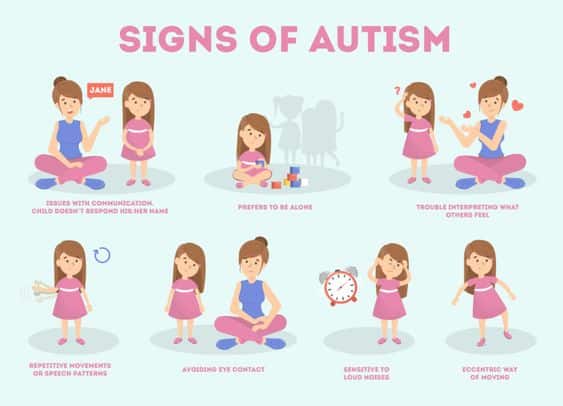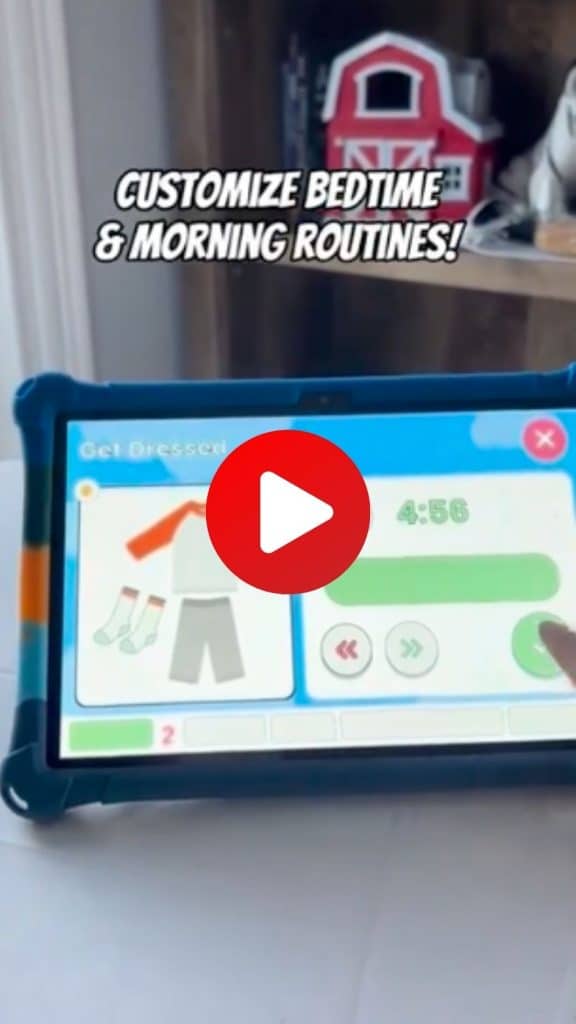My child isn’t responding to my commands right away. They aren’t playing with the other kids or singing Frozen songs. My child cuts his sandwiches straight down the middle instead of diagonally! Does my child have autism? Woah woah woah, ease up there. It’s good that you are concerned about your child’s development, but let’s take a step back. It’s unlikely that your child has autism. Autism is much more likely to be first noticed when your child is in school. Learn more about the signs of autism below!
Table of Contents
5 Signs of Autism
1. Sensitivity to Background Noise
Although all children may exhibit negative reactions to loud sounds, children with autism have a particularly strong aversion to loud noises. This may cause them to react by grimacing or wincing, rather than showing surprise or a normal wide-eyed curiosity. Signs of autism may be if you see your child convey their strongest emotions in the form of an adverse reaction to the music or TV being turned up too loud… or if adults in the room are having a loud and animated conversation… or even when you run the vacuum cleaner. Children with autism process the world around them differently. They may have trouble filtering out background sounds coming from the microwave or washing machine; sounds that would disappear as white noise for neurotypical children. These reactions may result in fits, crying, anger, or even physically aggressive behavior.
Goally | Visual Scheduler for Autism
Does your child struggle with getting ready in the morning independently? Goally’s routine app on the best tablet for kids breaks down large tasks into small, achievable steps for autistic kids. Create custom routines with your own videos & pictures for every step.
2. Difficulty Recognizing Facial Expressions and Keeping Eye Contact
Early on children learn to make eye contact with their parents, smile when they are being smiled at, and point or wave at things they find interesting. Children on the autism spectrum have a harder time recognizing emotion in facial expressions and may show little to no emotion themselves. For example, if something falls off the counter it’s normal for a child to look at their parents and process their facial expression to see what the reaction is. This is done as a way to verify if they too need to be concerned with what just happened. However, signs of autism would be a child having no reaction at all, which for a parent, can be very puzzling and concerning. Because children on the spectrum have trouble reading facial expressions, they may fail to react when a parent or sibling expresses joy, anger, or sorrow.
3. Speech and Language Difficulties
Children with autism may struggle to communicate and speak at the same level as their peers of the same age. In fact, even during infancy, you may notice that your child isn’t cooing in response to your attempts to interact and communicate. Typically, by the time a child reaches their first birthday, they’re able to speak a word or two. However, children who are on the autism spectrum may not develop their speaking abilities until later in life. Interestingly, some children with autism do coo during their first few months of life, but then suddenly stop communicating altogether. In these cases, all forms of verbal communication and typical language development abruptly come to a halt.

Read more: Autism Facial Expressions | Parents Guide
This can be disconcerting for parents. Often it’s a sign that it’s time to investigate further by seeking professional help. Sometimes children with autism do speak and demonstrate pretty typical signs of normal language development, they often repeat unrelated words and phrases over and over and, in essence, speak without really communicating or conveying a feeling, thought or desire. Early intervention is key to helping your child learn to communicate, whether it’s through spoken language or even through sign language if necessary.
4. No Interest in Interacting With the World
For the neurotypical child, the world is full of bizarre and wonderful things that they have never seen or encountered before; things that naturally interest and draw them in. The normal response to a new experience or discovery is typically wide-eyed excitement. Children with autism respond to the world very differently. You might notice that your child doesn’t really respond with eye contact or normal outward signs of curiosity when you try to get their attention. They might not even turn their head in your direction when you say their name. Signs of autism might be them not pointing at objects, showing a normal level of curiosity, or attempting to engage with you.
Read more: 5 Early Signs of Autism in Babies
A lack of responsiveness to stimuli and a lack of interest in trying to seek parental attention is a pretty common sign that a child may fall somewhere on the spectrum. Children typically learn through imitation. Even at an early age, the neurotypical child will begin copying adult behaviors, like them pretending to cook, holding an object up to their ear as if they are talking on the phone, or pretending to feed and care for a doll.
5. Sensory Stimuli Results in Overreaction or No Reaction
Many people with autism have trouble processing sensory information and can become easily overwhelmed. Sights, sounds and movements, even tastes and smells, can all be overwhelming to a child with autism. You may notice either an observable overreaction or an under-reaction to stimuli. In the case of an overreaction, they may avoid touch. I could be something as gentle like a pat on the head or a touch on the arm. Others may throw a fit when getting dressed because the sensation of the clothing creates a feeling of anxiety.

Read more: What are the Colors of Noise?
If your child has autism, they may exhibit signs of hypersensitivity to noise and other stimuli. For instance, your child may not respond to sounds that would usually startle or surprise other children. This can be so unusual that you might begin to wonder if your child is experiencing hearing problems. It’s normal for children to have a strong negative reaction to new and overwhelming things. However, if your child doesn’t react at all, that can be concerning. For example, if you take your child to the circus for the first time and they don’t respond to the clown by either laughing or freaking out, it could be a red flag that your child needs further evaluation.
Early Signs of Autism in Babies
- Declining eye contact
- Limited or no response to their name
- Reduced emotion in facial expressions
Signs of Autism in a 1-2 Year Old
- Doesn’t speak more than 15 words
- Can’t walk (or walk on tiptoes)
- Doesn’t know functions of household items like fork
- Does not imitate parents’ actions or words
- Doesn’t use items for their own purposes
- Does not follow simple instructions
Signs of Autism in a Toddler (3-4 Year Old)
- Doesn’t make eye contact
- Plays by themselves
- Doesn’t answer questions properly
- Does not tell stories
- Doesn’t understand certain concepts like time
- Does not socialize
- Performs repetitive behaviors
- Doesn’t like physical contact
- Has difficulty in understanding feeling
- Doesn’t respond when their name is called
- Is not able to form sentences
- Speaks in flat tone
Goally is a valuable resource for clinicians who are looking for ways to support children with speech and language problems.
- Individualized Instruction. Goally can be easily customized to meet the specific needs of each child supporting the skills that they need most, at each child’s own pace.
- Increased Engagement. Goally is a fun and interactive tool that can help children stay engaged while learning.
- Improved Communication. Goally helps children learn to effectively communicate wants and needs, and allows children to participate in the world around them.
- Bonus: Goally’s Core Word Lessons teaches kids their first 50 words through video modeling and interactive practice.
Goally’s distraction-free kid’s tablet can be used as a therapy tool to help teach executive function, language, emotional regulation, finger dexterity skills, and more!
Recognizing the signs of autism in kids is crucial for early intervention and support. By being aware of common indicators such as social communication challenges, repetitive behaviors, sensory sensitivities, and delayed language development, parents and caregivers can seek professional guidance and resources to help their child thrive. It is important to remember that every child is unique, and autism presents differently in each individual. Seeking a professional evaluation is the first step towards understanding and supporting children with autism, fostering their development, and providing them with the tools they need to navigate the world successfully. With early identification and appropriate interventions, children with autism can reach their full potential and lead fulfilling lives.
FAQ’s About Signs of Autism
What are some common signs of autism? Some common signs of autism include difficulty with social interactions, delayed speech and language development, repetitive behaviors, and hypersensitivity to noise and other stimuli. At what age can signs of autism be detected? Signs of autism can typically be detected as early as 2-3 years of age, but sometimes even earlier. Is there a test to diagnose autism? There is no single test to diagnose autism, but doctors may use a combination of behavioral evaluations, developmental screenings, and medical tests to make a diagnosis. Can autism be cured? There is no known cure for autism, but early intervention and therapy can help improve outcomes and quality of life for individuals with autism. Can children with autism attend school? Yes, children with autism can attend school. Special education programs and accommodations can be provided to help meet their unique needs.
This post was originally published on 06/28/2021. It was updated on 11/18/2023.

Goally
We help parents teach their kids life skills, like doing bedtime and morning independently. Backed by science, we incorporate evidence-based practices and expert-informed designs in all of our apps and content.








